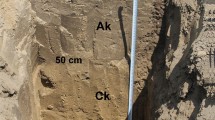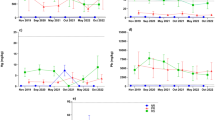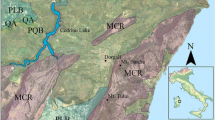Abstract
Purpose
Erosion is one of the main soil degradation problems. It diminishes soil biological activity and therefore its quality. The aim of the study was to evaluate if the application of two biostimulation processes could significantly increase biological activity, and therefore productivity, in soils deteriorated by erosion. This was done without synthetic fertilizers but with treatments accessible for farmers, in line with the 2030 Agenda for Sustainable Development. In particular, the addition of a soil microorganism suspension or Macrocystis pyrifera algae concentrate was evaluated.
Materials and methods
Soil samples were taken from a field area (Bihor County, Romania) affected by surface erosion processes. In particular, microbial mass, dehydrogenase activity (DHA), and the bacteria and fungi presence were analyzed for three soil uses (corn, black locust and uncultivated field with terracing) and in different locations (above a slope, at the midpoint and below it). A bio-stimulation process (addition of a microbial suspension or seaweed concentrate based on the Macrocystis pyrifera algae; incubation for 24 h) was used in order to improve the activity of the soil with the lowest values of activity.
Results and discussion
Statistical differences in DHA, bacterial numbers, and microbial biomass were found depending on field use and the areas from which the soil samples were gathered. Higher values of the biological parameters were in general recorded in the middle part of the slope, because they favor bioaccumulation processes (e.g., actual and potential dehydrogenase activity values of about 3 mg TPF/10 g dry soil). The use of microbial suspensions did not significantly stimulate DHA for the soils with a low biological potential. This activity was stimulated by adding the seaweed concentrate to the soil.
Conclusions
The use of the seaweed concentrate can be a good practice for improving activity in eroded soil. The study provides useful indications for better soil fertility management, in line with many of the goals of the 2030 Agenda For Sustainable Development.




Similar content being viewed by others
References
Alef K (1995) Dehydrogenase activity. In: Alef K, Nannipieri P (eds) Methods in applied soil microbiology and biochemistry. Academic Press, London, pp 228–231
Andjelković M, Van Camp J, De Meulenaer B, Depaemelaere G, Socaciu C, Verloo M, Verhe R (2006) Iron-chelation properties of phenolic acids bearing catechol and galloyl groups. Food Chem 98:23–31
Arioli T, Mattner VS, Winberg PC (2015) Applications of seaweed extracts in Australian agriculture: past, present and future. J Appl Phycol 27:2007–2015
Atlas RM (2004) Handbook of microbiological media, third edition. Taylor & Francis Inc, Boca Raton, USA
Balser T, Kinzig A, Firestone M (2002) The functional consequences of biodiversity. In: Kinzig A, Pacala S, Tilman D (eds) The functional consequences of biodiversity. Princeton University Press, Princeton, pp 265–293
Battacharyya D, Babgohari MZ, Rathor P, Prithiviraj B (2015) Seaweed extracts as biostimulants in horticulture. Sci Hortic 196:39–48
Berlyn GP, Russo RO (1990) The use of organic biostimulants to promote root growth. Below Gr Ecol 1:12–13
Blunden G, Morse PF, Mathe I, Hohmann J, Critchleye AT, Morrell S (2010) Betaine yields from marine algal species utilized in the preparation of seaweed extracts used in agriculture. Nat Prod Commun 5(4):581–585
Brzezińska M, Stępniewski W, Stępniewska Z, Przywara G (2001) Effect of oxygen deficiency on soil dehydrogenase activity in a pot experiment with Triticale CV. Jago Veg Int Agrophysics 15:145–149
Campos JA, Peco JD, De Toro JA et al (2018) Approach to the potential usage of two wood ashes waste as soil amendments on the basis of the dehydrogenase activity and soil oxygen consumption. J Soils Sediments 18:2148–2156
Cavigelli MA, Robertson GP (2000) The functional significance of denitrifier community composition in a terrestrial ecosystem. Ecology 81:1402–1414
Craigie JS (2011) Seaweed extract stimuli in plant science and agriculture. J Appl Phycol 23:371–393
Dincă L, Spârchez G, Dincă M (2014) Romanian’s forest soil GIS map and database and their ecological implications. Carpathian J Earth Environ Sci 9(2):133–142
El-Naggar A, Lee SS, Awad YM, Yang X, Ryu C, Rizwan M, Rinklebe J, Tsang DCW, Ok YS (2018) Influence of soil properties and feedstocks on biochar potential for carbon mineralization and improvement of infertile soils. Geoderma 332:100–108
Eurostat (2017) Agri-environmental indicator - greenhouse gas emissions. Available at http://ec.europa.eu/eurostat/statistics-explained/index.php/Agri-environmental_indicator_-_greenhouse_gas_emissions. Accessed Dec 2018
FAO (2015) Global guidelines for the restoration of degraded forests and landscapes in drylands: building resilience and benefiting livelihoods. Forestry paper no. 175. Rome: FAO
Fierer N, Schimel JP, Holden PA (2003) Variations in microbial community composition through two soil depth proles. Soil Biol Biochem 35:167–176
Fuentes-Ponce M, Moreno-Espíndola I, Pávela Sánchez-Rodríguez LM, Ferrara-Guerrero MJ, López-Ordaz R (2016) Dehydrogenase and mycorrhizal colonization: tools for monitoring agrosystem soil quality. Appl Soil Ecol 100:144–153
Geisseler D, Horwath W, Scow K (2011) Soil moisture and plant residue addition interact in their effect on extracellular enzyme activity. Pedobiologia 54:71–78
Gomiero T (2013) Alternative land management strategies and their impact on soil conservation. Agriculture 3(3):464–483
Grenni P, Rodríguez-Cruz MS, Herrero-Hernández E, Marín-Benito JM, Sánchez-Martín MJ, Barra Caracciolo A (2012) Effects of wood amendments on the degradation of terbuthylazine and on soil microbial community activity in a clay loam soil. Wat Soil Air Poll 223:5401–5412
Griggs D, Stafford-Smith M, Gaffney O, Rockström J, Ohman MC, Shyamsundar P, Steffen W, Glaser G, Kanie N, Noble I (2013) Policy: sustainable development goals for people and planet. Nature 495(7441):305–307
Gömöryová E, Střelcová K, Fleischer P, Gömöry D (2011) Microbial characteristics at the monitoring plots on windthrow areas of the Tatra National Park Slovakia.: their assessment as environmental indicators. Environ Monit Assess 174:31–45
Khan W, Rayirath UP, Subramanian S, Jithesh MN, Rayorath P, Hodges DM, Critchley AT, Craigie JS, Norrie J, Prithiviraj B (2009) Seaweed extracts as biostimulants of plant growth and development. J Plant Growth Regul 28:386–399
Kieft T, Amy P, Brockman F, Fredrickson J, Bjornstad B, Rosacker L (1993) Microbial abundance and activities in relation to water potential in the vadose zones of arid and semiarid sites. Microb Ecol 26:59–78
Lundquist E, Scow K, Jackson L, Uesugi S, Johnson C (1999) Rapid response of soil microbial communities from conventional, low input, and organic farming systems to a wet/dry cycle. Soil Biol Biochem 31:1661–1675
MacKinnon SA, Craft CA, Hiltz D, Ugarte R (2010) Improved methods of analysis for betaines in Ascophyllum nodosum and its commercial seaweed extracts. J Appl Phycol 22:489–494
Malusá E, Sas-Paszt L, Ciesielska J (2012) Technologies for beneficial microorganisms inocula used as biofertilizers. Sci World J 2012:491206
Moeskops B, Buchan D, Sleutel S, Herawaty L, Husen E, Saraswati R, Setyorini D, De Neve S (2010) Soil microbial communities and activities under intensive organic and conventional vegetable farming in West Java, Indonesia. Appl Soil Ecol 45:112–120
Muller A, Bautze L, Meier M, Gattinger A, Gall E, Chatzinikolaou E, Meredith S, Ukas T, Ullmann L (2016) Organic farming, climate change mitigation and beyond. IFOAM EU. Available at: http://www.ifoam-eu.org/sites/default/files/ifoameu_advocacy_climate_change_report_2016.pdf. Accessed Dec 2018
Munteanu I (1997) Review of soil and terrain data, human-indiced soil degradation and soil vulnerability assessment in Romania. In: BatjesNH, Bridges EM (Eds). Implementation of a soil degradation and vulnerability database for central and Eastern Europe (SOVEUR project). Proceedings of an international workshop Wageningen, 1–3 October 1997. FAO and ISRIC, pp. 69–72. Available at http://www.isric.org/sites/default/files/2017-03/SOVEUR_Proc97.PDF (Accessed April 2018)
Nabti E, Jha B, Hartmann A (2017) Impact of seaweeds on agricultural crop production as biofertilizer. Int J Environ Sci Technol 14:1119–1134
Nakamura T, Nagayama K, Uchida K, Tanaka R (1996) Antioxidant activity of phlorotannins isolated from the brown alga Eisenia bicyclis. Fish Sci 62:923–926
Nannipieri P, Grego S, Ceccanti B (1990) Ecological significance of the biological activity in soil. In: Bollag JW, Stotzky G (eds) Soil biochemistry, vol 6. Marcel Dekker Inc, New York, USA, pp 293–355
Nannipieri P, Trasar-Cepeda C, Dick RP (2018) Soil enzyme activity: a brief history and biochemistry as a basis for appropriate interpretations and meta-analysis. Biol Fertil Soils 54:11–19
Nielsen MN, Winding A (2002) Microorganisms as indicators of soil health. National Environmental Research Institute, Denmark. Technical Report No. 388, 82
Norrie J, Keathley JP (2006) Benets of Ascophyllum nodosum marine-plant extract applications to ‘Thompson seedless’ grape production. Acta Hortic 727:243–248
Obbard JP (2001) Ecotoxicological assessment of heavy metals in sewage sludge amended soil. Appl Geochem 16:1405–1411
Onet A, Teusdea A, Boja N, Domuta C, Onet C (2016) Effects of common oak Quercus robur L. defoliation on the soil properties of an oak forest in Western plain of Romania. Annal Forest Res 59(1):33–47
Possinger AR (2013) Using seaweed as a soil amendment: effects on soil quality and yield of sweet corn Zea mays L. Open access master’s theses. Paper 78
Romero E, Fernandez-Bayo J, Diaz J, Nogales R (2010) Enzyme activities and diuron persistence in soil amended with vermicompost derived from spent grape marc and treated with urea. Appl Soil Ecol 44:198–204
Salazar S, Sanchez L, Alvarez J, Valverde A, Galindo P, Igual J, Peix A, SantaRegina I (2011) Correlation among soil enzyme activities under different forest system management practices. Ecol Eng 37:1123–1131
Schimel JP, Gulledge JM, Clein-Curley JS, Lindstrom JE, Braddock JF (1999) Moisture effects on microbial activity and community structure in decomposing birch litter in the Alaskan taiga. Soil Biol Biochem 31:831–838
Schloter M, Nannipieri P, Sorensen SJ, Dirk Van Elsas J (2018) Microbial indicators for soil quality. Biol Fertil Soils 54:1–10
Schumacher BA (2002) Methods for the determination of total organic carbon toc. in soils and sediments. Ecological Risk Assessment Support Center. US. Environmental Protection Agency pp. 23
Soan BD (2017) The role of organic matter in soil compactibility: a review of some practical aspects. Soil Tillage Res 16:179–201
Setboonsarng S, Gregorio EE (2017). Achieving sustainable development goals through organic agriculture: empowering poor women. ADB Southeast Asia working paper series no. 15. Available at: https://www.adb.org/sites/default/files/publication/384836/swp-15.pdf. Accessed Dec 2018
Stolte J, Tesfai M, Øygarden L, Kværnø S, Keizer J, Verheijen F, Panagos P, Ballabio C, Hessel R (2016) Soil threats in Europe: status, methods, drivers and effects on ecosystem services. A review report, deliverable 2.1 of the RECARE projec EUR 27607 EN. JRC Technical Reports 206 pp. Available at https://esdac.jrc.ec.europa.eu/public_path/shared_folder/doc_pub/EUR27607.pdf. Accessed Sept 2018
Subhani A, Changyong H, Zhengmiao Y, Min L, El-ghamry A (2001) Impact of soil environment and agronomic practices on microbial/dehydrogenase enzyme activity in soil. A review. Pak J Biol Sci 4:333–338
Tóth G, Stolbovoy V, Montanarella L (2007) Soil quality and sustainability evaluation an integrated approach to support soil-related policies of the European Union – a JRC position paper. European Commission, Joint Research Centre, Institute for Environment and Sustainability. EUR 22721 EN. Office for Official Publications of the European Communities, Luxembourg, 40 pp. Available at http://eusoils.jrc.ec.europa.eu/ESDB_Archive/eusoils_docs/other/EUR22721.pdf. Accessed Dec 2018
Tóth G, Hermann T, da Silva MR, Montanarella L (2018) Monitoring soil for sustainable development and land degradation neutrality. Environ Monit Assess 190(2):57
United Nations (UN) 2015. Transforming our world: the 2030 agenda for sustainable development. Resolution adopted by the general assembly on 25 September 2015, A/RES/70/1. UN General Assembly: New York
Trevors JT (1984) Dehydrogenase activity in soil. A comparison between the INT and TTC assay. Soil Biol Biochem 16:673–674
Van Veen JA, Van Overbeek LS, Van Elsas JD (1997) Fate and activity of microorganisms introduced into soil. Microbiol Mol Biol Rev 61(2):121–135
Vekemans X, Godden B, Penninckx MJ (1989) Factor analysis of the relationships between several physico-chemical and microbiological characteristics of some Belgian agricultural soils. Soil Biol Biochem 21:53–57
Visser S, Parkinson D (1992) Soil biological criteria as indicator of soil quality: soil microorganisms. Am J Alternative Agr 7:33–37
Wall A, Heiskanen J (2003) Water-retention characteristic and related physical properties of soil on afforested agricultural land in Finland. Forest Ecol Manag 186:21–32
Wang T, Jonsdottir R, Ólafsdóttir G (2009) Total phenolic compounds, radical scavenging and metal chelation of extracts from Icelandic seaweeds. Food Chem 116:240–248
Wilson M, Lindow SE (1993) Release of recombinant microorganisms. Annu Rev Microbiol 47:913–944
Wolińska A, Stępniewska Z (2011) Microorganisms abundance and dehydrogenase activity as a consequence of soil reoxidation process. In: Miransari M (ed) Soil tillage & microbial activities. Research Singpost, Kerala, India, pp 111–143
Wolińska A, Stępniewska Z (2012) Dehydrogenase activity in the soil environment, dehydrogenases. Canuto RA (ed) InTech, https://doi.org/10.5772/48294. Available at: https://www.intechopen.com/books/dehydrogenases/dehydrogenase-activity-in-the-soil-environment. Accessed Dec 2018
Zhang N, He X, Gao Y, Li Y, Wang H, Ma D, Zhang R, Yang S (2010) Pedogenic carbonate and soil dehydrogenase activity in response to soil organic matter in artemisia ordosica community. Pedosphere 20:229–235
Zogg G, Zak D, Ringelberg D, Macdonald N, Pregitzer K, White D (1997) Compositional and functional shifts in microbial communities due to soil warming. Soil Sci Soc Am J 61:475–481
Yergeau E, Bell TH, Champagne J, Maynard C, Tardif S, Tremblay J, Greer CW (2015) Transplanting soil microbiomes leads to lasting effects on willow growth, but not on the rhizosphere microbiome. Front Microbiol 6:1436
Yuan B, Yue D (2012) Soil microbial and enzymatic activities across a chronosequence of Chinese pine plantation development on the loess plateau of China. Pedosphere 221:1–12
Zhu CJ, Lee YK (1997) Determination of biomass dry weight of marine microalgae. J Appl Pycol 9:189–194
Author information
Authors and Affiliations
Corresponding author
Additional information
Responsible editor: Yongtao Li
Publisher’s note
Springer Nature remains neutral with regard to jurisdictional claims in published maps and institutional affiliations.
Electronic supplementary material
ESM 1
(PDF 260 kb)
Rights and permissions
About this article
Cite this article
Onet, A., Dincă, L.C., Grenni, P. et al. Biological indicators for evaluating soil quality improvement in a soil degraded by erosion processes. J Soils Sediments 19, 2393–2404 (2019). https://doi.org/10.1007/s11368-018-02236-9
Received:
Accepted:
Published:
Issue Date:
DOI: https://doi.org/10.1007/s11368-018-02236-9




